|
Report from
Europe
Half UK tropical timber trade value
lost in May
As expected, following the UK lockdown in response to
COVID-19 introduced on 24 March and allowing for the
long lead time in the tropical trade, there was a very sharp
decline in UK imports of tropical timber products in May.
The total value of UK imports of all tropical wood (HS 44)
and wood furniture (HS 94) products during the month
was just over US$50 million, only half the value typical in
what is usually one the busiest months of the year for the
UK trade (Chart 1).
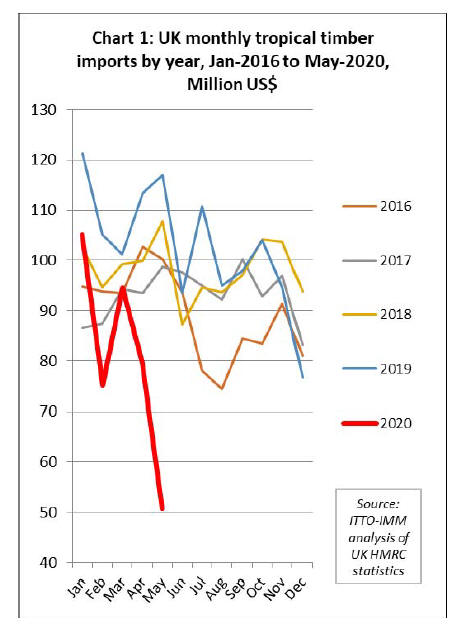
There was a large downturn in UK imports of all tropical
timber products in May. Imports of tropical wood furniture
were US$24.5 million during the month, compared to an
average of US$61.6 million for the same month in the
previous 5 years.
The same comparison for tropical plywood is US$11.5
million in May this year against the 5-year average of
US$14.3 million, for tropical joinery US$8.2 million in
May this year against the 5-year average of US$13.0
million, for tropical sawnwood US$3.3 million in May this
year against the 5-year average of US$8.3 million, and for
tropical mouldings/decking US$0.9 million in May this
year against the 5-year average of US$2.2 million (Chart
2).
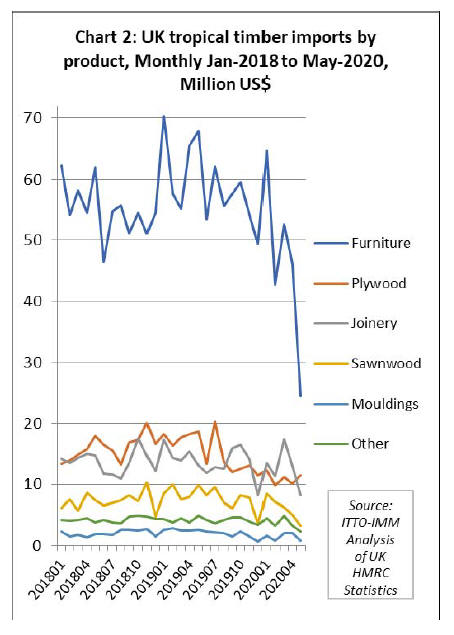
The sharp downturn in May, a direct result of the
COVID-19 lockdown measures, follows a period of more
gradual decline in UK imports of tropical timber products.
UK wood furniture imports from tropical countries have
been weakening since the start of 2019 and were
particularly slow in February this year. Imports of tropical
plywood and sawnwood have also been sliding since the
middle of 2019.
Comparing the first five months of 2020 with the same
period in 2019, total UK import value of tropical timber
products fell 27% to US$405 million.
Import value of wood furniture from tropical countries fell
27% to US$230.6 million, while imports of tropical
plywood were down 39% at US$54.9 million, tropical
joinery products were down 14% at US$63.4 million,
tropical sawnwood fell 31% to US$30.3 million, and
mouldings/decking declined 41% to US$7.7 million (Chart
3).
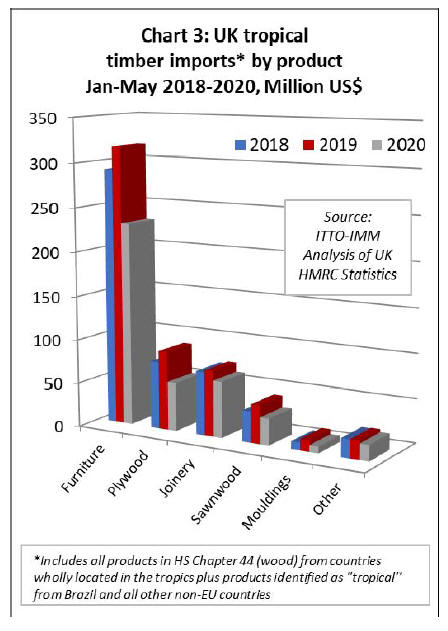
UK imports of wood furniture declined sharply from all
the leading tropical supply countries in the first five
months of this year (Chart 4). Imports from Vietnam were
down 26% at US$125.1 million, imports from Malaysia
fell 31% to US$46.5 million, imports from Indonesia
declined 31% to US$20.5 million, and imports from India
fell 31% to US$15.9 million.
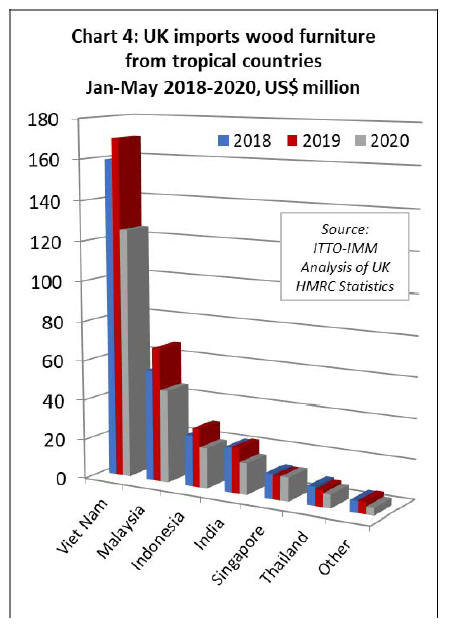
Indonesia loses ground in UK joinery market
After making gains in 2019, UK imports of tropical
joinery products from Indonesia, mainly consisting of
doors, fell 14% to US$38.6 million in the first five months
of this year. After a strong start to the year, UK imports of
joinery products from Malaysia and Vietnam (mainly
laminated products for kitchen and window applications)
stalled almost completely in May.
Total joinery imports in the first five months were down
12% to US$15.1 from Malaysia and down 11% to US$3.5
million from Vietnam. UK trade in joinery products
manufactured from tropical hardwoods in neighbouring
Ireland have also fallen dramatically this year, down 42%
to US$1.8 million in the first five months. (Chart 5).
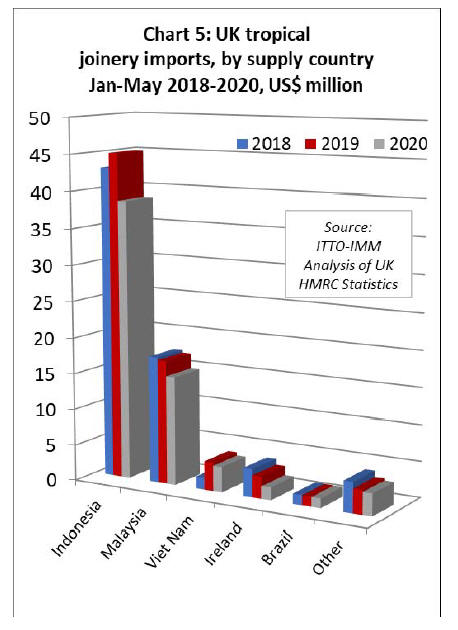
UK imports of tropical hardwood plywood from China
fall 60%
The UK imported 40,000 cu.m of tropical hardwood faced
plywood from China in the first five months of this year,
60% less than the same period last year. UK imports of
this commodity from China were at unusually high levels
in the first half of 2019 after a period of slow buying in
2018 due to Brexit uncertainty.
However, the market suffered from over-stocking in the
second half of last year as consumption slowed. This year,
UK imports have been further dampened by COVID
related supply problems in China.
Likely due to supply problems elsewhere, UK imports of
plywood from Malaysia, which have been in long term
decline, were recovering ground in the opening months of
2020. Despite significant slowing in May, imports from
Malaysia were still up 30% at 28,100 cu.m for the first
five months of the year.
However, imports from Indonesia were down 26% to
19,000 cu.m during this period, while imports from
Paraguay were 24% less at 2,700 cu.m. In recent years, the
UK has been importing small volumes of tropical
hardwood faced plywood from Latvia and Spain. In the
first five months of 2020, imports declined 8% to 3,800
cu.m from Latvia and 47% to 2,600 cu.m from Spain
(Chart 6)
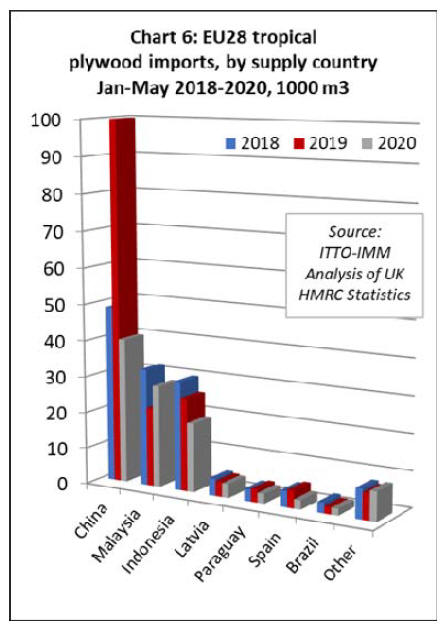
UK tropical sawn hardwood imports down 24% in year
to May
The UK is now a relatively minor market for tropical sawn
hardwood, importing less than 100,000 cu.m in each of the
last two years, making it only the fifth largest European
importer for this commodity (after Belgium, Netherlands,
France and Italy).
With the UK trade stagnating in May this year, imports
were well down from nearly all the major supply countries
by the end of the first five months. Total imports of 34,000
cu.m during this period were 24% less than the same
period in 2019.
UK tropical sawn imports are sourced from a large range
of countries, both directly in the tropics and indirectly
from other European countries (Chart 7). UK imports from
Cameroon, the leading supplier, fell 11% to 9,100 cu.m in
the five-month period, while imports from the Republic of
Congo declined 21% to 5,100 cu.m.
Of other African suppliers, imports were down 28% to
1,400 cu.m from Côte d'Ivoire, 94% to only 166 cu.m
from DRC and 33% to 704 cu.m from Ghana.
UK imports from Malaysia were 5,700 cu.m in the first
five months of 2020, 22% less than the same period in
2019.
Indirect imports into the UK via the Netherlands were
down 14%, at 3,600 cu.m, after significant growth last
year. Imports from Brazil fell 26% to 1,900 cu.m.
Of all countries supplying tropical sawnwood to the UK,
only Guyana recorded any growth in this market in the
first five months of 2020, rising 75% to 1,900 cu.m.
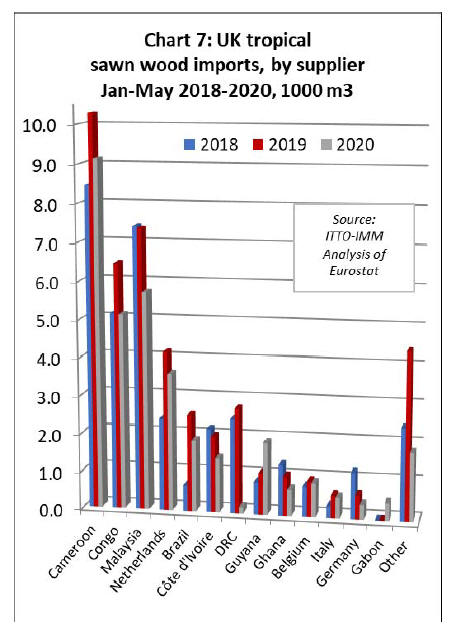
¡®Four years¡¯ to recover from record recession in the
UK
The key question now for the UK trade in tropical wood
products is what ¡°shape¡± will the recovery take following
the sharp fall in May (likely maintained in June given the
lead times involved): will it be a ¡°V-shaped rebound¡±; or a
¡°tick mark¡± with the sharp fall followed by a longer tail of
recovery; or, worst case, an ¡°L-shape¡± where trade barely
recovers and bounces along at the lower level for many
months?
This is difficult to forecast with any confidence given
continuing uncertainty over prospects for a second wave
of the virus in the UK and the long-term effects of the
lockdown and of the government¡¯s policy response on
jobs, consumer confidence, and business investment. That
is before factoring in other key sources of uncertainty,
such as on-going negotiations towards a post-Brexit trade
agreement with the EU, and the profound effects of the
virus on wood production in tropical countries and
competing supply regions.
The latest forecasts of growth in the UK economy are not
optimistic and imply that hopes of a V-shaped recovery
are fading. On the other hand, there are some more
positive signals from the construction sector, a more direct
driver of timber demand, and new government support
measures have potential to boost consumption.
In their latest report, the EY Item Club, a leading UK
economic forecasting body, warns that the economy may
not get back to pre-pandemic levels before 2024. The
organisation expects a record recession as the UK
economy contracts by 11.5% this year followed by a slow
rebound.
Unemployment will more than double, it says, from 3.9%
to 9%, leaving roughly three million people out of work as
the furlough scheme ends. Job losses and poor real wage
growth will lead to a collapse in consumer confidence and
hold growth back.
According to the EY Item Club report, ¡°even though
lockdown restrictions are easing, consumer caution has
been much more pronounced than expected. Consumer
confidence is one of three key factors likely to weigh on
the UK economy over the rest of the year, alongside the
impact of rising unemployment and low levels of business
investment.¡±
Recent economic data in the UK has been inconsistent.
Retail sales jumped in June by 13.9%, more than expected
by most forecasters. The flash purchasing managers¡¯ index
for business activity in the UK also registered solid growth
for July.
However, these improvements come from a very low base.
Deloitte¡¯s consumer confidence tracker for the UK found
that households were emerging from the second quarter in
a slightly improved but still highly cautious mood.
Recovery in the UK manufacturing sector is also proving
to be elusive. According to the Confederation of British
Industry industrial trends survey, the manufacturing sector
remained in a deep downturn in June. Output volumes fell
at a record pace in the three months to June, exceeding the
previous record in May.
More positive, particularly for having a more direct
bearing on timber demand, is that June data pointed to a
sharp turnaround in the performance of the UK
construction sector.
The phased restart of building work on site in the UK
helped to lift output volumes and boost business
confidence in this sector. At the same time, new orders
stabilised after three months of sharp declines and
purchasing activity expanded at the fastest rate since
December 2015.
The headline seasonally adjusted IHS Markit/CIPS UK
Construction Total Activity Index jumped to 55.3 in June,
from 28.9 in May, to signal a strong increase in total
construction output. Moreover, the latest reading signalled
the steepest pace of expansion since July 2018.
Residential building was the best-performing area of UK
construction activity in June. Around 46% of respondents
to the IHS Markit/CIPS survey noted an increase in
housing activity, while only 27% experienced a reduction.
Commercial work and civil engineering activity also
returned to growth in June, although the rates of expansion
were softer than seen for house building.
The index measuring business expectations in the
construction sector for the year ahead remained
historically subdued but climbed to its highest since
February amid a boost from the reopening of work on site.
46% of the survey panel anticipate a rise in business
activity, while 31% forecast a reduction. The latter mostly
commented on concerns about the wider UK economic
outlook.
To help improve that outlook, on 8th July, the UK
government announced GBP30 billion in additional
spending measures to boost demand, retain jobs, and get
young people into employment. This was the second major
fiscal response to the COVID-19 crisis and represents a
new phase of response from the Government.
From the perspective of wood demand, probably the most
significant measure is a temporary holiday on stamp duty
for all property transactions up to a threshold of
GBP500,000. The last time such a holiday was introduced
was 2009, following the Global Financial Crisis, it did turn
out to be an effective measure for boosting transactions in
the housing market. The benefit of transactions in this
market is that they tend to be paired with other forms of
activity, including in sectors, like furniture, particularly
relevant to wood product suppliers in tropical countries.
According to UK government figures, there were 48,450
UK residential property transactions in May 2020, which,
while 16.0% higher than April 2020, was still 49.6% lower
than May 2019, and 6.2% lower than at the lowest point in
the financial crisis, which was January 2009. It is hoped
the stamp duty holiday will lead to a more significant
increase in transactions in August and September.
Also included in the government¡¯s announcement was
GBP1 billion in funding to improve public buildings and
GBP2 billion of Green Home Grants, with grants of up to
GBP10,000 for each household towards retrofitting
properties to be energy efficient. This should help boost
demand and activity in the UK joinery sector.
The UK and EU ¡°still some way off reaching
agreement¡± on Brexit deal
Following negotiations in London in the week ending 24
July, the UK and EU have said they still remain some way
off reaching a post-Brexit trade agreement. This was the
second official negotiation round to be held in person
since the coronavirus crisis, after both sides agreed to
"intensify" talks in June.
EU chief negotiator Michel Barnier said a deal looked "at
this point unlikely" given the UK position on fishing rights
and post-Brexit competition rules. The EU is demanding
that the UK tie itself closely to the bloc¡¯s state aid, labour
and environmental standards to ensure it does not undercut
the EU¡¯s single market with poor-quality goods.
Mr. Barnier said there was a risk of no deal being reached
unless the UK changed course on these topics, which were
"at the heart" of the EU's trade interests. He added that an
agreement would be needed by October "at the latest" so it
could be ratified before the current post-Brexit transition
period ends in December.
His UK counterpart David Frost said "considerable gaps"
remained in these areas, but a deal was still possible. The
UK has ruled out extending the December deadline to
reach a deal. The two sides' chief negotiators are meeting
again informally in London in the last week of July, with
another round of official talks scheduled for mid-August
in Brussels.
In his regular weekly blog on 27 July, under the heading
¡°Any deal is better than no deal¡±, the CEO of the UK
Timber Trade Federation David Hopkins called on
members to put more pressure on the Government to
ensure a deal with the EU is secured.
Mr. Hopkins highlighted the ¡°increased bureaucracy,
increased costs, and increased time to move goods across
borders¡± seen in the UK government¡¯s new publication for
the Border Operating Model.
https://www.gov.uk/government/publications/the-borderoperating-model).
He was also critical of the new UK Global Tariff regime.
¡°On the face of it, this is a positive document for trading
with the rest of the world, with the stated intention to
lower the tariffs currently in existence and simplify the
framework¡±.
¡°However¡±, says Mr. Hopkins, ¡°in the event of a no deal
exit it will have exactly the opposite effect on imports from
Europe, our main trading partner, imposing duty on many
products that have been duty free within the single
market¡±.
Mr Hopkins identified the following ¡°obvious problems
for the wood sector¡± created by the new tariff regime:
¡°First, the UK Global Tariff introduces tariffs on imports
of European plywood and laminated timber products of
between 6 and 10%. This will reduce the competitiveness
of these products in the market ¨C possibly pushing buyers
towards competing non-timber alternatives or products
from outside Europe with lower transparency and worse
track record on performance.
¡°Secondly, it seems to provide a disincentive to
manufacturing certain products and adding value within
UK borders. For example, manufacturing of certain
joinery items such as door sets, windows or I-beams, can
use laminated sections as components or feedstock. These
components could now face tariffs of up to 10% adding
costs to the manufacturing process.
¡°However, paradoxically, importing fully manufactured
items of joinery or I-beams will attract considerably lower
tariffs of zero to two per cent. Under this scenario, what
would be the point of maintaining manufacturing in the
UK ¨C with the associated costs of machinery, trained
skilled staff and so on ¨C when one could simply import the
products from abroad?¡±.
Mr. Hopkins concludes, ¡°Of course, it may not come to
this. The scenario described above could easily be solved
by negotiating and agreeing a comprehensive free trade
deal with the EU, thus eliminating the need for tariffs¡±.
|